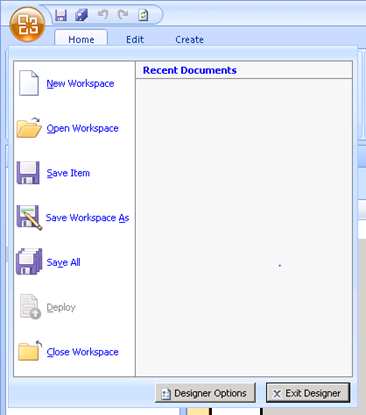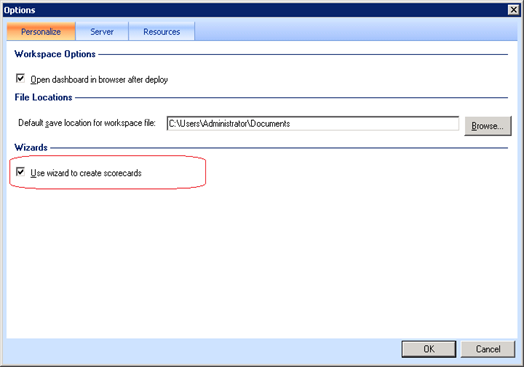How to Turn On/Off the Wizard for Score Card Designer
To turn on the Wizard for Score Card in Dashboard designer, click on the Office Icon in top left corner

Click on the Designer Options button in the Menu.

|
||||||
|
How to Turn On/Off the Wizard for Score Card Designer To turn on the Wizard for Score Card in Dashboard designer, click on the Office Icon in top left corner
Click on the Designer Options button in the Menu.
Business problem The sales person sending document to marketing team, meanwhile the sales team has done some content organization reshuffled the documents to subfolder and different document libraries. If someone tries to pullout the document using the URL, they wouldn’t be able to find it.
Overview of Document ID Document ID is the new feature in SharePoint 2010. By enabling the document ID feature, it assigns the unique ID to every document in Site Collection. Irrespective of location the document ID would help the user to find the document.
Activate Service Activate the Document ID Service feature at Site Collection level to generate the ID for documents.
Now every document in the site collection has the unique ID. The link to document can be defined with “DocIdRedir.aspx?ID=xxxxxx” DocIdRedir.aspx accepts the query string ID in the URL, which would be used to lookup the document using its unique ID, then it will be redirected to the current location of the file. http://intranet.contoso.com/_layouts/DocIdRedir.aspx?ID=YHNNQ7JVKVWQ-1-1
Change Document ID Can I change the document ID prefix? Yes Go to -> Site Actions -> Site Settings -> (Site Collection Administration) Document ID Settings
Change the Text in “Begin IDs with the following characters”
I was working on creating my new codeplex tool for Site Governance to automate the process of creating the site based on the request. The site will be provisioned programmatically using the object model in custom actions associated with SPD workflow. While building this action, I was trying to get the list of site templates and ID’s to automate the creation process. Finally, figured out the PowerShell cmdlet does the magic of listing all ID’s J Get-SPWebTemplate is very useful PowerShell cmdlet to list the ID and templates.
Issue: When you try to get data from Data Connection for e.g. web service. You get the following error: “The amount of data that was returned by a data connection has exceeded the maximum limit that was configured by the server administrator. Form elements, such as drop-down lists may be blank.”
Cause: The Default data connection response size if set to 1500kb for Form Services, If the response from the data connection size exceeds the default limit the warning will be shown on screen. Resolution: Click on General Application Settings in Central Administration Click on Configure InfoPath Forms Services under InfoPath forms Services
Change the Response Size in kilobytes.
When you try to add attachments to the InfoPath Browser Enabled form, you may get the following error. If the attachment file size is beyond the configured maximum user session data. “The Selected file is too large and is causing the form to exceed the amount of allowable resources. Select another file.”
Resolution: Click on General Application Settings in Central Administration Click on Configure InfoPath Forms Services under InfoPath forms Services
The file attachments will be kept in session for the user in state service. Increase the maximum size of user session data in kb, to allow large attachments.
PowerShell always gives the administrator the feel of programming, Basically I am a developer not really much into using the options or menus to do the tasks like backup (I never used the backup option in Central AdministrationJ) Let’s talk about Backup of Site Collection using PowerShell with examples. Syntax: Backup-SPSite <<Site Collection URL>> -Path <<File Path>> [-Force] [-Confirm] [-NoSiteLock] [-UseSqlSnapshot]
Example 1: Backup-SPSite http://localhost -Path C:\SiteBackup.bak
Creates the backup of the site collection, the backup file will be stored in C: drive named as SiteBackup.bak
Example 2: Backup-SPSite http://localhost -Path C:\SiteBackup.bak -Force When the job is scheduled to take the daily backup, if the backup file already exists in the specified path, the backup process would be terminated.
Using -Force will enforce overwrite on existing file.
Example 3: By default the Bacup-Site command let will set the site collection as read only, while the backup is in progress to avoid updates and/or prevent the backup file from corruption. Using -NoSiteLock switch will not lock the site collection to read only, while backup in progress.
Example 4: Switch
You might have noticed the following error logged into the EventLog. “Load control template file /_controltemplates/TaxonomyPicker.ascx failed: Could not load type ‘Microsoft.SharePoint.Portal.WebControls.TaxonomyPicker’ from assembly ‘Microsoft.SharePoint.Portal, Version=14.0.0.0, Culture=neutral, PublicKeyToken=71e9bce111e9429c’.”
There is an encoded char issue in .ascx control: Open the TaxonomyPicker.ascx in the 12 hive control templates path:
Replace “,” with double quote
This issue still exists after installing my October 2010 Cummulative Updates. Day 2: How to get help for PowerShell cmdlet, like syntax or list of mandatory/optional parameters to be used with cmdlet. Get-Help is the cmdlet to provide help for the cmdlet. Syntax: Get-Help <<cmdlet>> Example: Let’s get help for Get-Help Get-Help Get-Help
This is the series of PowerShell Scripts in SharePoint 2010. Learn a cmdlet (command-let) a day. Cmdlet(Command-let) Cmdlet’s are compiled commands installed with PowerShell. When you start “SharePoint 2010 Management PowerShell”, the console starts with pre-loaded cmdlets. Day 1: Get-Command
|
||||||
| An unhandled exception was generated during the execution of the current web request. Information regarding the origin and location of the exception can be identified using the exception stack trace below. |
Stack Trace:
|
[COMException (0x81020026): List does not exist. The page you selected contains a list that does not exist. It may have been deleted by another user.<nativehr>0x81020026</nativehr><nativestack></nativestack>] Microsoft.SharePoint.Library.SPRequestInternalClass.GetListsWithCallback(String bstrUrl, Guid foreignWebId, String bstrListInternalName, Int32 dwBaseType, Int32 dwBaseTypeAlt, Int32 dwServerTemplate, UInt32 dwGetListFlags, UInt32 dwListFilterFlags, Boolean bPrefetchMetaData, Boolean bSecurityTrimmed, Boolean bGetSecurityData, Boolean bPrefetchRelatedFields, ISP2DSafeArrayWriter p2DWriter, Int32& plRecycleBinCount) +0 Microsoft.SharePoint.Library.SPRequest.GetListsWithCallback(String bstrUrl, Guid foreignWebId, String bstrListInternalName, Int32 dwBaseType, Int32 dwBaseTypeAlt, Int32 dwServerTemplate, UInt32 dwGetListFlags, UInt32 dwListFilterFlags, Boolean bPrefetchMetaData, Boolean bSecurityTrimmed, Boolean bGetSecurityData, Boolean bPrefetchRelatedFields, ISP2DSafeArrayWriter p2DWriter, Int32& plRecycleBinCount) +278 [SPException: List does not exist. The page you selected contains a list that does not exist. It may have been deleted by another user.] Microsoft.SharePoint.SPGlobal.HandleComException(COMException comEx) +27257906 Microsoft.SharePoint.Library.SPRequest.GetListsWithCallback(String bstrUrl, Guid foreignWebId, String bstrListInternalName, Int32 dwBaseType, Int32 dwBaseTypeAlt, Int32 dwServerTemplate, UInt32 dwGetListFlags, UInt32 dwListFilterFlags, Boolean bPrefetchMetaData, Boolean bSecurityTrimmed, Boolean bGetSecurityData, Boolean bPrefetchRelatedFields, ISP2DSafeArrayWriter p2DWriter, Int32& plRecycleBinCount) +27639327 Microsoft.SharePoint.SPListCollection.EnsureListsData(Guid webId, String strListName) +623 Microsoft.SharePoint.SPListCollection.ItemByInternalName(String strInternalName, Boolean bThrowException) +27372020 Microsoft.SharePoint.SPListCollection.get_Item(Guid uniqueID) +114 Microsoft.SharePoint.Publishing.CommonUtilities.GetListByID(SPWeb web, Guid listID, Boolean attemptCleanup) +346 Microsoft.SharePoint.Publishing.Internal.CachedVariationSettings.GetVariationLabelsList(SPWeb rootWeb) +123 Microsoft.SharePoint.Publishing.Internal.CachedVariationSettings..ctor(Guid siteId, SPUrlZone zone) +183 Microsoft.SharePoint.Publishing.Internal.<>c__DisplayClass1.<CreateVariationSettings>b__0() +429 Microsoft.SharePoint.<>c__DisplayClass4.<RunWithElevatedPrivileges>b__2() +729 Microsoft.SharePoint.Utilities.SecurityContext.RunAsProcess(CodeToRunElevated secureCode) +27488118 Microsoft.SharePoint.SPSecurity.RunWithElevatedPrivileges(WaitCallback secureCode, Object param) +27187865 Microsoft.SharePoint.SPSecurity.RunWithElevatedPrivileges(CodeToRunElevated secureCode) +93 Microsoft.SharePoint.Publishing.Internal.CachedVariationSettings.CreateVariationSettings(Guid siteId, SPUrlZone zone, Boolean forceRefresh) +131 Microsoft.SharePoint.Publishing.Internal.WebControls.PublishingRibbonTrimmer.TrimVariationsGroup() +193 Microsoft.SharePoint.Publishing.Internal.WebControls.PublishingRibbonTrimmer.TrimPublishTab() +52 Microsoft.SharePoint.WebControls.SPPageStateControl.OnPreRender(EventArgs e) +621 Microsoft.SharePoint.Publishing.Internal.WebControls.PublishingPageStateControl.OnPreRender(EventArgs e) +788 System.Web.UI.Control.PreRenderRecursiveInternal() +108 System.Web.UI.Control.PreRenderRecursiveInternal() +224 System.Web.UI.Page.ProcessRequestMain(Boolean includeStagesBeforeAsyncPoint, Boolean includeStagesAfterAsyncPoint) +3394 |

Version Information: Microsoft .NET Framework Version:2.0.50727.4952; ASP.NET Version:2.0.50727.4955 